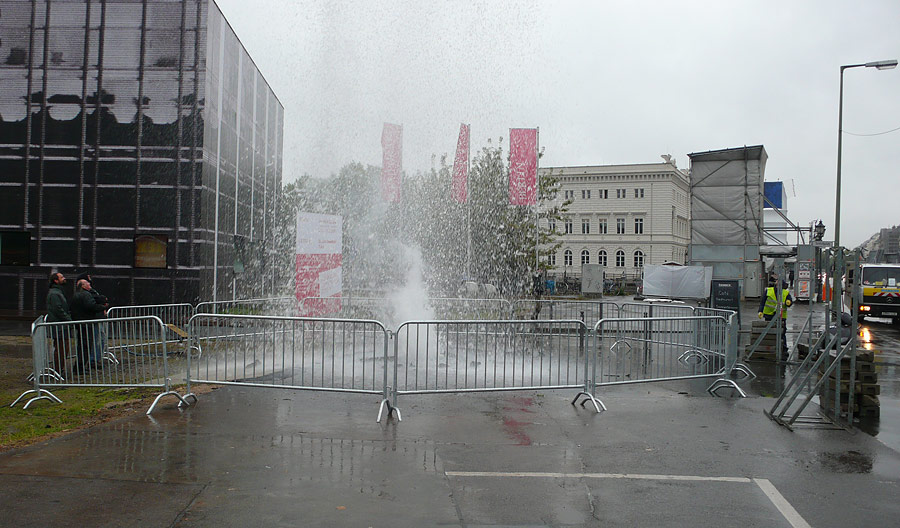An Enjoyable Post-Structuralist Mess
The hole in the ground looked as though it had been broken open by that special kind of violence reserved for nature only. Clumps of tarmac lay strewn across the pavement, and guard rails had been erected around the opening. It was raining quite hard, and at first it looked like a sink-hole had opened up and was about to swallow part of the inner city. I asked a guy in a green raincoat what was going on. He didn’t look as though he was from the Berlin water board, or in any kind of hurry.
“In about two minutes a jet of water is going to shoot out of the hole. It’ll be about 20 meters high,” he explained. Although I was still a little confused, it became apparent that this was theater, and not some impending natural disaster. Slightly dissapointed, I stuck around to see what would happen.
The artificial geyser didn’t quite reach 20 meters, but for a couple of seconds the possiblility of an awesome drenching did seem quite real. Two other technicians clarified the situation further: the geyser is part of a four-day “theater spectacle” called The Giants Arrive, by the French theater group Royal de Luxe. Huge mechanical puppets will roam the streets of Berlin until Sunday, playing out a mythical, fairy-tale version of Berlin’s divided past.
It occurs to me again that the center of Berlin is becoming less and less real, whatever that might be. The building on the left in the photo is the Temporäre Kunsthalle, which is currently clad in an inkjet print of the façade of the Palast der Republik. It’s an installation called Echo, by artist Bettina Pousttchi, and is probably supposed to be evocative and eerie, but for me falls way short of being engaging in any way whatsoever. It seems tired. Sometimes simple things are good because they’re simple; and sometimes simple things are dull because they’re trying too hard to be good by being simple.
So what’s the center of Berlin about? It’s about simulation, reflection, ironic comment, symbolic gesture, detached recontextualisation, artistic intervention and nostalgic whitewashing. The old GDR parliament building is gone. A hammy rehash of the old Prussian palace is to be rebuilt at vast cost. An increasingly unused lawn now covers the site like a tragic bowling green. A pneumatic geyser, built by theater technicians, errupts from the location’s substrata which, not 100 meters distant is the object of study for archeological teams. And a wooden art barn, built to be dismantled, finds meaning by dressing up in clothes it can’t afford to wear.
Am I having fun living in a metaphor?
Where’s a French post-structuralist when you need one? Maybe it’s time to reread Baudrillard. Except we still wouldn‘t understand it.
